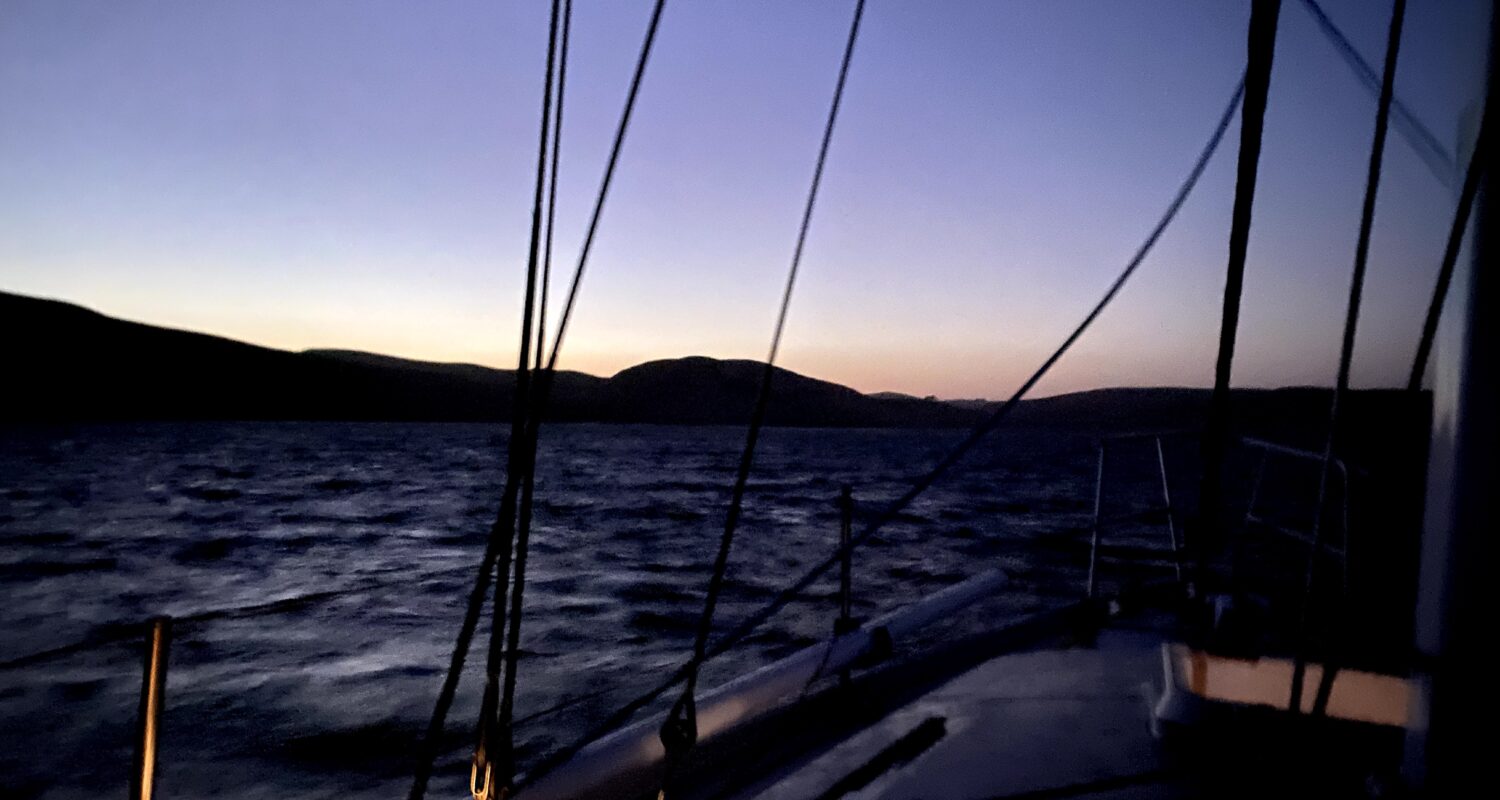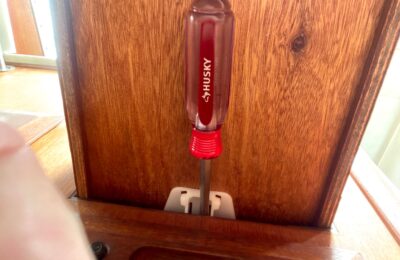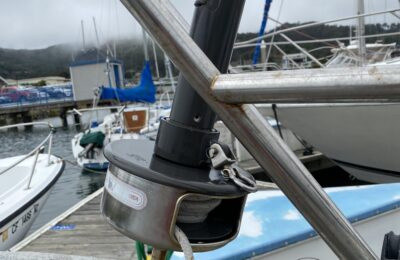TLDR: I took an overnight trip to Drake’s Bay, north of San Francisco with two friends. Anchoring out in high winds was a little scary, but we had a nice trip nonetheless.
The San Francisco Bay is one of the finest natural harbors in the world, but it took European seafaring explorers a surprisingly long time to find it. As early as 1542 Spanish explorers were moving up the California coast from what became Mexico but, so the story goes, the first ship to enter the San Francisco Bay was that of Lieutenant Juan Manuel de Ayala in 1775. So where did everyone stop instead?
Perhaps not everyone, but Francis Drake at least went ashore in 1569 in the lee of the peninsula we now call Point Reyes, north of San Francisco. The crescent of water just south is named Drake’s Bay in his honor. I have done a couple of fun beer can races recently with fellow Ericson owner Bryan on his boat and he was game to go along with me for a cruising adventure. We extended the invitation a bit wider and enlisted Dolores, another crew member from Bryan’s beer can posse and an experienced sailor to boot. I felt good about embarking on the trip with people who knew more about sailing than I do.
We left Sausalito on Thursday morning near the end of an ebb tide and scooted out into the slot. We had the Aries oar kicked down before we left the dock and for a few nice moments on our way out to Point Bonita, we had enough wind for vane steering. Passing the light, the wind dissipated and we had balmy rollers and no wind. We flipped on the Yanmar engine and Raymarine wheel pilot to drive us up the coast toward Stinson Beach.
By around noon we had reached Bolinas, mostly halfway to Drake’s Bay. The rolled and I turned green enough to puke a little bit. I felt like a great host, barfing over the side while my guests/crew looked on.
Things got better as the wind picked up from the low single digits into the teens. With the engine off and the sails up we were working directly into a northerly headwind. We rolled in the jib and took a reef in the main. The Aries wind vane was happy to keep us on course.
The wind built more and I was in the cockpit when a percussive “thunk!” gave a strong indication that some part of the rig had broken. Scanning the spars it was apparent that a shackle holding the outermost block on my main sheet had failed. We slowed a bit and considered options. I considered a soft shackle replacement, but the hole in the turning block was too narrow to have accommodated the doubled 1/8th” dyneema I had on hand. We decided to scavenge another metal shackle from a different block that could be eliminated.
This area – the coast of California near San Francisco – is in terms of oceanic wildlife, like a rainforest. Porpoises everywhere, sea birds, seals, fish and whales. So many, many whales, a fluke here, a spout there.
The afternoon was beautiful, shining sun, nearly flat wave height.
I clambered up on the top of the cabin house to detach the sacrificial block and re-use the shackle to re-attach the outboard mainsheet turning block. At this point we spotted a humpback posse. Bryan and Dolores shouted, “The whales, the whales, look at the whales!” Still with the taste of my brunch-time puke in the back of my throat, I focused on the shackle in front of my face, desperate not to drop any small parts overboard. I turned briefly to look out at the whales that were of so much interest, and sure enough as I looked over, I saw four humpback heads rise out of the water simultaneously in some sort of prey-corralling called “bubbling:”
The picture above doesn’t really do it justice.
It was by all accounts, amazing to see in the wild. I don’t know what they were eating (sardines or something?) Great masses of birds trying to participate in the fray. At this point I found myself hurtling backward, trying to equilibrate myself between the short distance work I had of reassembling the shackle in my hands and the near-religious experience of watching the whales feed in this way. There was only one thing left for my body to do – to puke again from the most profound depths of my digestive system.
Continued great hosting/skippering by yours truly. Bryan and Dolores were ever so gracious about my physical distress, sharing with me ginger pills and an acupressure wristband to alleviate my inner ear imbalances.
We avoided the whale pod, and continued on long beautiful tacks northward toward Drake’s Bay. Summer sunshine and a stiff breeze. The ‘normal’ wind pattern for this part of the coast could be described as Northwest, or North-Northwest, but by the time we arrived it was blowing 25 knots directly from the North.
I’ve practiced anchoring, but never done it for an overnight period planning to sleep on the boat. I have a Bruce style anchor that is meant to be good for securing a hold in a sandy or silty surface, which is what one finds at Drake’s Bay. There were two other boats already anchored, a 40-45’ motor yacht and a cruising sailboat about the same size as Sure Shot. Dolores suggested we circle the area and ensure we had the right depth in a circumference to match the length of chain and rope we would deploy. I have about 25’ of chain and 120’ of rope and we were in about 14 feet of water near high tide. This is close to a 10:1 scope, so a nice flat pull on the rode and anchor.
After puttering around we dropped the anchor, decided we were too close to the neighboring motor yacht and then repositioned and dropped again. Bryan said he saw up to 27 knots on the anemometer as we were getting settled. Why must the best, strongest wind of the day blow once we want to settle down?
But the anchor held and everything seemed okay. The GPS is amazingly specific and we could keep the display on showing our position to the thousandths of a minute decimal place. I set an anchor drag alarm on my Multi Function Display (Chartplotter Computer). At least I believed I had set the alarm, but I had not tested the system before departing. The wind kept the rode taut and thus we never swung around much or enough to trigger the narrowest 65’ anchor drag limit.
We decided we should take turns waking up on the hour to see if our position had shifted. This could be monitored easily from the glow of the GPS coordinates on the instrument panel.
I was in charge of dinner and served chicken apple sausages, some steamed vegetables and a Zatarin’s rice sodium explosion mix. Dolores brough much-appreciated cookies and after dinner we played Quirkle Rummy, a card game for entertainment. Night fell and the wind did not abate.
We took turns waking each hour to assess our safety. The anchor held well, but it made for less restful sleep to say the least. We were probably only a few minutes from bashing into one of the few neighboring boats or the lee shore if the anchor had broken free.
The wind settled gradually between two and four AM and it was as if the boat itself relaxed. At dawn the air was nearly still and beautiful and clear.
I shut down Chartplotter around 3am once the wind had subsided and when I turned them back on in the morning, the anchor drag alarm went off (because in the slack air we had drifted more than 65 feet from where I set the alarm). This was reassuring.
Dolores made a great breakfast for us, egg scramble and homemade banana bread. Hot coffee and tea.
Of course, by 9am when we were ready to get under way, the wind was absent entirely. I felt cheated after having slept through such a harsh blow, only to find glassy water when we could have used some oomph. (“I demand a refund!” he shouted at the sky….)
We pulled up the anchor by hand for the rope rode and with my manual windlass for the chain portion. The anchor was clean as a whistle, indicating a sandy bottom as opposed to the muddy mess of bay mud where I have used it before. Porpoises, seals, Pelicans and others dotted the bay.
We engaged the Yanmar and headed out around Pt. Reyes to see if we could get far enough West to find some wind. Motoring for perhaps an hour or so, mostly west to southwest. A breeze started to fill in and it was a good opportunity to practice mounting the pole for wing-on-wing downwind sailing. One jaw end of my second-hand spinnaker pole had jammed and had to be convinced to open with pliers and lubricant. It all worked eventually.
The day was sunny and bright but the sky was marred somewhat by the dregs of forest fire smoke slipping out across Marin County. Which fire? Pick one of a half dozen. Sad, annoying, blegh.
Listening to observations from Bryan and Dolores, I learned how to use the Aries a bit better. Bryan’s operating principle, “If you want the boat to steer starboard, pull the starboard vane orientation control line once. This rule was too obvious for me to have realized it on my own. My process beforehand was:
- Set the course, balance the sails.
- Fiddle with the vane paddle until it is properly oriented into the wind.
- Proceed as such until changing course is needed.
The ability to make small course adjustments with the Aries control lines permits the reversal of the process.
Poled-out wing-on-wing we achieved 4kts of boat speed in 8kts of wind entirely DDW. This is remarkable in that the wind is comparatively light and the vane was trying to steer downwind.
Eventually we passed Stinson and Muir Beaches, and headed back under the Golden Gate with a mix of a half-dozen container ships and a couple dozen recreational fisherman. We stowed the spinnaker pole and took some short runs.
Ducking under the Golden Gate Bridge, we found ourselves in a typical pushing-20 kts-in-the-slot situation. The air was smokey and strange as we turned left and headed up to Sausalito. The Marin Headlands spat out flumes of warm, smokey air. Wind direction shifted from the east, back to the northwest. Kind of a mess. We rolled in the jib and dropped the main and motored back up the Richardson Bay to my marina. In all, it was a very fun overnight trip.
Of course, using the boat reveals ever more things that need to be fixed/corrected.
-The forward hatch I re-bed last spring seems to admit green water into the V-berth. I will probably have to pull it and try again with the bedding.
-I need to reseat my stuffing box (tighten it again).
-Somewhere I have a small diesel leak in my newly re-installed engine
-When I have more people on the boat I need to be better organized. I find the idea of taking inventory of all of my little cubbies and shelves somewhat boring, but I need to do it to solve problems and to be able to answer questions. I also need to organize my safety-talk pre-sail speech for guests a little better.



